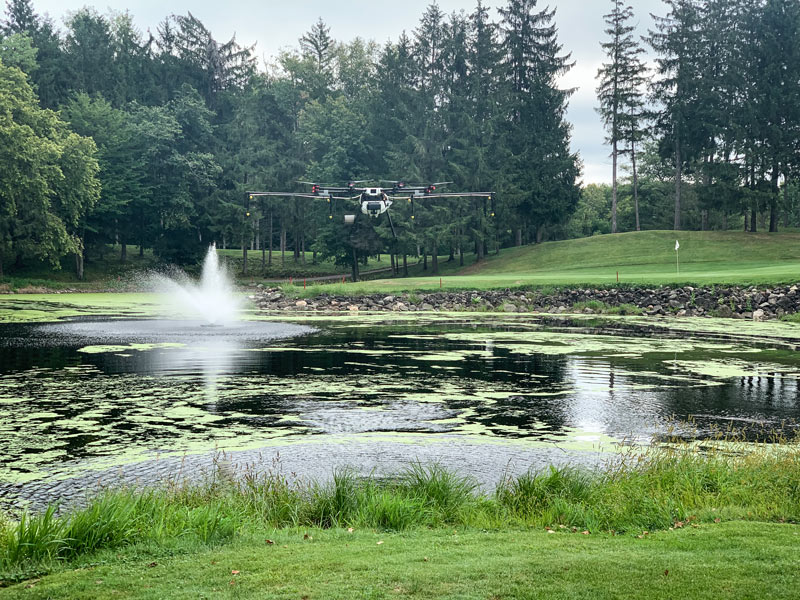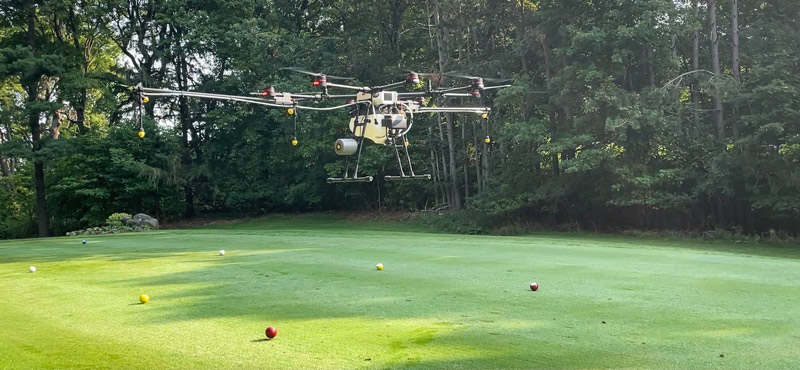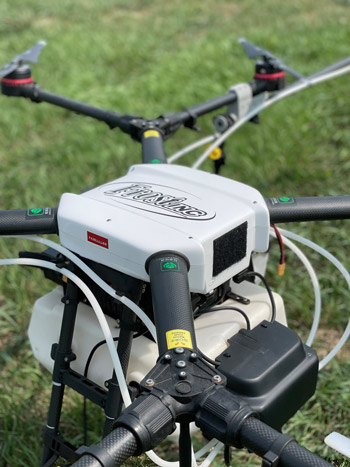
Accessing a duckweed-plagued pond? No sweat for a drone. Delivering inputs to just such hard-to-reach areas is an emerging use for the technology on golf courses. Photo courtesy of Ken Rost
Just a couple of days apart in late August, two golf course superintendents more than 1,000 miles apart offered a tantalizing glance at what may become part of the future of golf course maintenance.
While unmanned aerial vehicles — UAVs, or drones — already have myriad uses on golf courses, these superintendents demonstrated yet another: spraying. Though the technology still isn’t quite ready for prime time, the recent not-so-dry runs showed the potential in remote inputs from above.
“I think the technology will be there in time, especially for the bigger drones,” says Alan FitzGerald, MG, GCSAA Class A superintendent at LedgeRock Golf Club in Mohnton, Pa., and a 24-year association member. “Right now, for fine turf, it’s not quite there, primarily because the application rate is so low. Productivity-wise, we can put a guy on a GPS sprayer, and that’s much more efficient. But for out-of-play areas, handwork, tough-to-get areas, I think it could be a big thing. It should save a lot of labor down the road.”
Ryan Cochran of Five Points Ag Services in New Holland, Pa., visited LedgeRock on Aug. 24 and conducted a short test run. He loaded his drone’s small spray tank with tracker dye and “painted” a bunker with it. FitzGerald tweeted a video of the drone in action.
Not long after, Ken Rost of Frost Inc. in St. Croix Falls, Wis., stopped by Luck (Wis.) Municipal Golf Course. Rost has recently begun exploring the possibility of expanding his ag-based drone spraying program into the golf course space and wanted the challenge afforded by Luck Muni’s notoriously forested terrain.
After Rost had taken a few flights, Luck superintendent Kevin Clunis, CGCS, had an epiphany: The course hadn’t been able to treat for duckweed this season, and Clunis had noticed it had begun to bloom.
“I asked if (Rost) would consider making an aquatic spray,” says Clunis, a 39-year GCSAA member. “He said he didn’t know how it would act over water. I told him, ‘Why not fly it over the pond and see what you can do?’ I also had a fountain going, and he wanted to see how the accident-avoidance would go with the fountain. Of course, all our golfers were enamored to see this thing. They’d all stop and watch.”
Rost tweeted a video of the pond application, creating yet another social media ripple.
“I think there could be some applications for this on golf courses,” Clunis says. “Remote areas, pond applications, between the back tees, when it’s hard to get equipment in there. ... It’s just going to take some more time. They’re still trying to figure some things out.”
Opportunity and obstacles
The two golf course drone spray experiments were connected by more than just the fact that they were attempts to figure out this tech, ahem, on the fly. The pilots, Cochran and Rost, are both application services contractors with Rantizo, an Iowa City, Iowa-based company that sells equipment and services for agricultural drone spraying.
“We first looked into the golf space 18 months to two years ago,” says Michael Ott, CEO of Rantizo who co-founded the company 3½ years ago. “It just wasn’t ready at that time. The product just wasn’t ready, and we knew we needed to do some enhancements. We’ve come leaps and bounds since then.”
Rantizo has 50 contractors from coast to coast, and though commercial agriculture is the company’s meal ticket, Ott says, “Golf is a new expansion area. I think what you saw in those videos will become more common in the next two or three years.”
Watch a drone from Rantizo lay down an application from overhead (in this test run, blue tracker dye on a bunker) at LedgeRock Golf Club in Mohnton, Pa.:
Spray-by-drone still has many obstacles and limitations. First, while anyone can fly a drone up to a certain size for purely recreational reasons in certain areas, commercial applications require a specific Federal Aviation Administration license. The application of pesticides from above is a whole other matter.
It’s complicated for Rost by the fact that Frost Inc. is located just northeast of Minneapolis, on the Minnesota-Wisconsin border, and licensing requirements often vary by state.
“The path we had to take to do this ... it’s not an easy path,” Rost says. “There’s quite a bit of licensing with the FAA and the states and EPA groups. There’s the regular license for pesticide application in addition to an aerial applicator’s license. We spent all winter doing that.”
Frost Inc., affiliated with the Minnesota, Wisconsin and South Dakota chapters of GCSAA, served the larger spraying market long before it began exploring the drone component. It recently dabbled in drone spraying of stadium seats with disinfectant in response to the coronavirus pandemic, and Rost says the company has made money by concentrating its drone efforts on high-value, low-acre specialty ag applications — spraying vineyards and orchards and cannabis, hemp, pumpkin and strawberry fields.
“We’re still in the process of learning about drone applications,” Rost says. “Golf is a primary market for us (spraying traditionally), so that’s why we’re poking at that market with the drones, trying to find out what the value proposition is for it.”

Ken Rost of Frost Inc. dropped in with a drone at Luck (Wis.) Municipal Golf Course in August to practice piloting the device on a heavily forested site. Photo courtesy of Ken Rost
Application rate is another issue, as FitzGerald learned during his test. Though Cochran did a quick demonstration with a drone equipped with a 14-foot boom over LedgeRock’s fairways — “That thing moves,” FitzGerald marveled — the superintendent’s primary interest is in spraying smaller, hard-to-reach areas of the course. LedgeRock has undulating, often steep terrain. FitzGerald particularly hopes to target those out-of-play fescue areas between tees, for instance, that often land at the bottom of his to-do list.
“We have a lot of areas that are hard to get machines on,” he says. “It’s all handwork, areas where we can barely get the Ventrac with a brush cutter to cut it. I wanted to see if we could get something on there to spray it.”
As the bunker-dye test proved, there won’t be an issue with accessibility. The drone will be able to spray those fescues, and FitzGerald had a follow-up scheduled with Cochran to run a test using actual product, but that appointment was postponed because of weather. But ...
“It’s spraying at ag rates,” FitzGerald says. “I spray fairways at a gallon per 1,000 square feet, or 40 gallons per acre. This thing’s spraying 2 gallons per acre, so it’s a whole different animal — concentrated chemical not watered down in the spray tank. That’s the biggest concern for me. In my fescue areas, coverage doesn’t have to be 100% perfect. My concern is how well that would work on bluegrass. That’s one reason we sprayed in the bunker, and the coverage looked good at the 9-gallon-per-acre rate. I just don’t know the efficacy of that lower rate.”
Cochran did eventually return to LedgeRock to apply actual product. He says he spent just under four hours spraying “three little patches” totaling roughly 2 acres.
“It’s still a learning experience,” Cochran says. “It’s going to take some more honing. The drone is designed to spray fairly flat fields. We can do really steep hills, but it has to go really slow to adjust to the terrain. With some of the products we were using, (FitzGerald) wanted 10 gallons per acre. The most I can do with how it’s set up is about 7. What we did was two applications of 5 gallons per acre. There are some different pumps and nozzles I can change up to get up to that 10-gallons-per-acre coverage. I think it has some potential.”
Licensing and spray rates aren’t the only limitations.
“The drone does apply at a lower gallon-per-acre or per-1,000-square-feet than what ground rigs do,” Rost says. “The other thing is, when they’re running ground rigs, they’re not just spraying one product. They’re spraying fungicide, insecticide, adding fertilizer, wetting agents, plant growth regulators ... all kinds of stuff. They put a lot of stuff in the tank and spray at one rate. That’s how you get the job done. With a drone, you’re very limited. You can’t put fertilizer in it. There’s just too much volume to the fertilizer. You could spray fungicide and pesticide at that lower rate, but you’re not likely to put two products in the tank at once, so it would be a separate mission for each product. That’s a real head-scratcher for superintendents. It’s so different from what they’re accustomed to doing.”

Right: The drone from Frost Inc. trialed at Luck Municipal Golf Course. Photo courtesy of Ken Rost
A related issue is labeling.
“Product labels have a recommended rate. They might say 20 or 80 gallons per acre, but 4 gallons per acre is not part of the label,” Rost says. “In New York, for instance, it’s actually illegal to spray amounts that aren’t on the label. In Minnesota, that’s not a problem; it’s not illegal to do that. But one thing we do know is that Bayer Crop Science, for example, is aware that drones are coming into the market, and they’re planning to start creating product labels that show drone product rates.”
Pump up the volume
Another hiccup is pure volume. Rantizo’s DJI Agras MG-1P drone is fitted with a 10-liter (that’s just over 2½ gallons) tank. Battery life — and, thus, flying time — is listed at nine to 12 minutes in the best case. It can be shortened to around five minutes depending on payload, wind speed and several other factors.
“The typical volume a drone can carry is just 2 to 3 gallons,” Rost says, “compared to a ground rig of 200 or 300 gallons. That’s just an inordinate amount of missions if you’re spraying large areas. It’s just not feasible.”
Rantizo has an answer for that. Ott, the CEO, says Rantizo is the only company permitted by the FAA to operate a drone swarm in rural areas in the lower 48 states. One Rantizo pilot can fly three drones simultaneously, along with a visual observer, and the company is rolling out an automatic refilling system that, in combination with swarming, “really helps with productivity,” Ott says.
However, it’s not for the faint of heart. Or the unlicensed.
“I’ve seen some swarming in ag, and it’s a circus,” Rost says. “I’d say very few people can successfully run swarming operations, even in ag. The coordination has to be almost military. It’s not for amateurs, and I admit, I’m an amateur.”
And then there’s the “resolution” issue. Rost explains that a ground rig with 20-inch nozzle spacing and GPS and individual-nozzle control has a boundary resolution of 20 inches. “Boundary resolution” is essentially accuracy, or the ability to guarantee application precision without danger of overlap or gaps in application.
“The drone’s effective swath pattern is 12 feet,” Rost says. “We know we don’t have the actual application accuracy that we have with current GPS spray-control rigs. That’s important for plant growth regulators on greens and collars, for example. You might have different grasses and different PGRs for each of those grasses. Accuracy for spraying those areas is super important. Those are the limitations superintendents are talking to us about.”
Rantizo, however, claims to have solved that, too. Using real-time kinematics (RTK) positioning, it says it can resolve down to 3 centimeters, or just over an inch. But that, of course, is an additional expense.
Drones as a labor solution?
Given all of that, is golf course drone spraying simply a solution looking for a problem?
“What we’re trying to solve for is the labor problem that is common everywhere,” Ott says. “It’s an issue all over the place. The goal of Rantizo is to solve the labor issue. ... And (drones) are getting to places you just can’t get to with a ground-based sprayer — flying in the middle of ponds, dropping something to solve the algae problem, all those water features or hazards, or weeds that creep in at the edge of the water hazard. It’s an answer for that.”

Right: Rantizo’s drone used for the spraying test drive at LedgeRock Golf Club. Photo courtesy of Alan FitzGerald
Rantizo cautions that its services are best for small plots, hard-to-reach areas and spots where growth stage, for example, may not permit a ground approach. For larger areas, it touts the benefits of targeted spraying, and that application seems a good fit on a golf course.
Research has shown drones are particularly good at spotting disease pressure and drought stress, often before they’re visible to the naked eye. One needn’t squint too hard to see a future in which one drone scouts a golf course and another carries out a spray treatment.
Editor’s note: Newly interested in drones but not sure where to start? This primer will propel you through the basics of using a drone on a golf course and how you can capitalize on the collected images and data.
“There was a podcast with Dr. (Frank) Rossi at Cornell,” Rost says. “He’s intrigued by the opportunity of doing aerial applications at night when the golfers aren’t around at all. If you have a fungicide you know you need to get down with a tournament the next day, if you can go out with a drone and get the application done at night, no one would even know it happened.”
Pie in the sky? Hardly. The FAA recently relaxed restrictions on drone night flying, making such a method possible.
Pick your spots
Truth be told, until rules change, technology improves and costs decrease, golf courses aren’t in danger of being overrun with drone sprayers. But Rantizo contractors now charge by the hour instead of the acre, making small, one-off projects — like steep, out-of-play fescue areas in Pennsylvania or a duckweed-choked pond in Wisconsin — affordable.

Flying color (in this test run, blue tracker dye on a bunker) at LedgeRock Golf Club in Mohnton, Pa., on Aug. 24. Photo courtesy of Alan FitzGerald
“It wasn’t too expensive at all,” FitzGerald says. “In my mind, it works. There’s labor involved too (in spraying by hand) — the labor to put two guys on a hose, if I had two spray techs to put on it ... just trying to coordinate it. Or I can pay a contractor and have it taken off my list. It’s labor savings, and if you’re dedicating that labor, that means something else isn’t getting done.”
“We didn’t talk price,” Clunis adds, noting the drone visit was as much for Rost’s benefit as his own. “But that’s why I don’t have an aquatics license. It’s cheaper for me to hire somebody else. This is perfect for that, or for people with native areas to spray a herbicide where you can’t or shouldn’t be driving. That’s a great thing. It’s wonderful for that.”
Andrew Hartsock is GCM’s managing editor.